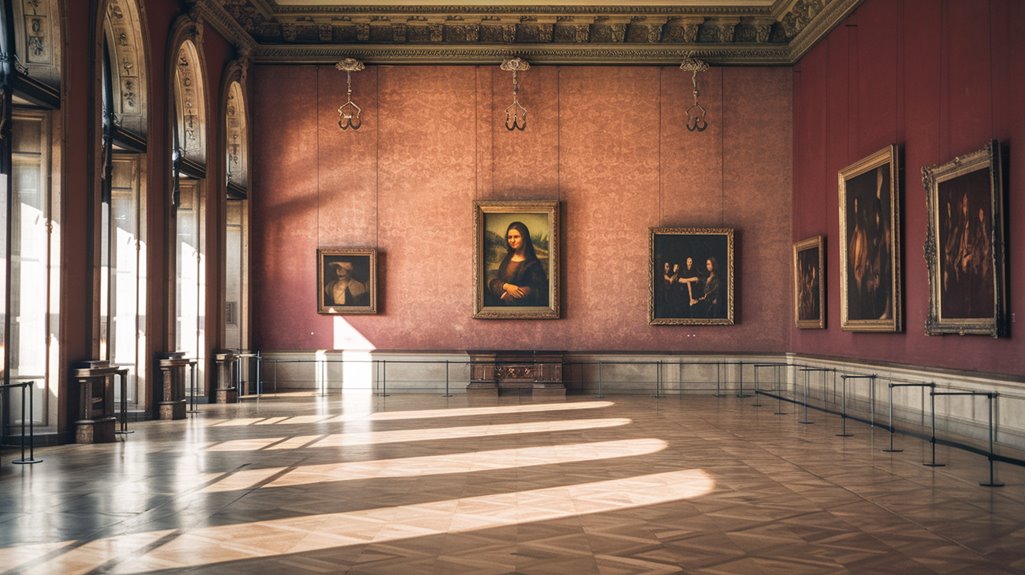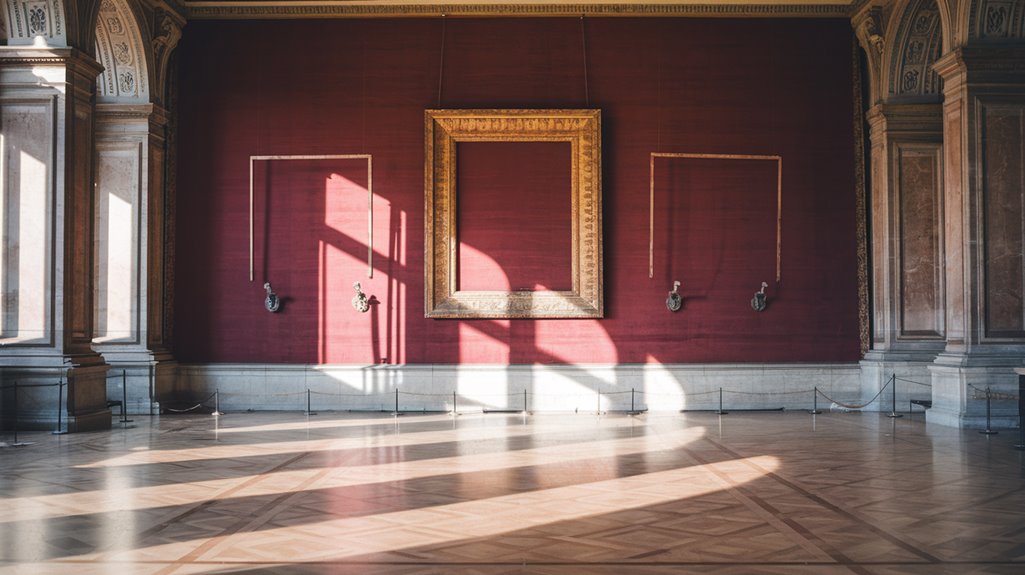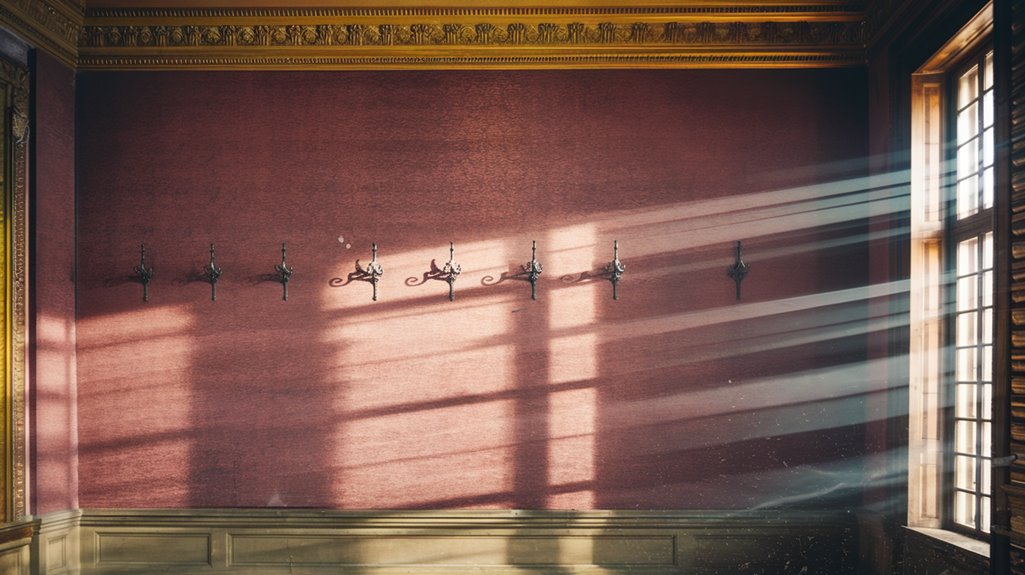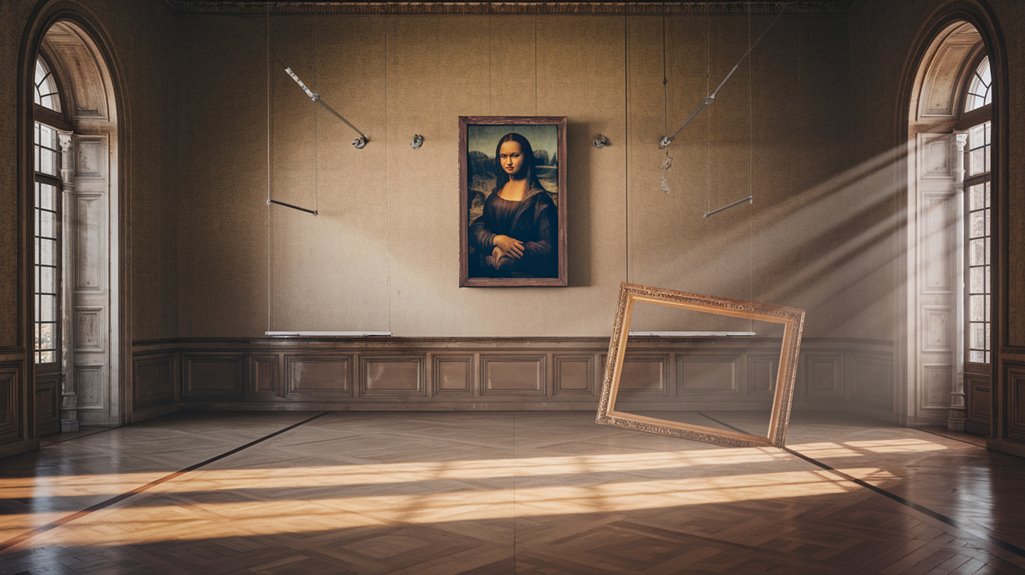The Mona Lisa Was Stolen—and Nobody Noticed
Like a ghost slipping through medieval walls, the world's most famous smile vanished into thin air one summer morning in 1911. You'd think someone would notice when a masterpiece goes missing from the Louvre, but you'd be wrong. For 24 hours, Leonardo da Vinci's Mona Lisa hung invisibly on the museum walls—or rather, didn't hang at all. The story of this audacious theft reveals more than just a security breach; it exposes how the most obvious crimes can hide in plain sight.
The Perfect Crime at the Louvre

While the Louvre's security staff conducted their routine morning rounds on August 21, 1911, they didn't notice that the world's most famous painting had vanished from its place in the Salon Carré.
What makes this art theft even more astonishing is that nobody realized the Mona Lisa was missing until the next day when a copyist arrived to work.
You'd think museum security would have been tighter, but the reality was quite the opposite.
With about 800 workers buzzing around the museum that morning—from cleaners to photographers—and elderly, poorly trained guards on duty, the conditions were perfect for a heist.
The museum was closed for cleaning, security was remarkably lax, and even when a thumbprint was found on the glass, investigators failed to use this vital piece of evidence. An expert recovered a distinct fingerprint from the frame but was unable to match it to any suspect.
The thief, Vincenzo Peruggia, had actually worked at the Louvre and knew the museum's layout well since he had been tasked with cleaning and reframing paintings.
Meet Vincenzo Peruggia: The Unlikely Art Thief
Before becoming the world's most notorious art thief, Vincenzo Peruggia was just another Italian handyman who'd moved to Paris seeking work.
You wouldn't have guessed this ordinary-looking museum worker would pull off history's most audacious art theft, but his position at the Louvre gave him the perfect cover. Wearing a white smock uniform, he managed to blend seamlessly with other museum employees.
Working as a handyman installing protective glass cases, Peruggia's access to the museum's masterpieces made his crime surprisingly simple. His initial motivation was allegedly that he believed Napoleon looted the masterpiece from Italy.
Here's what made him successful:
- He knew the museum's layout and security protocols
- His worker's uniform helped him blend in perfectly
- His job gave him legitimate reasons to handle artwork
The theft remained unsolved for two years until Peruggia's attempt to sell the painting in Florence led to his arrest.
He died in 1925, but his daring heist forever changed museum security.
How the World's Most Famous Painting Disappeared
On the quiet morning of August 21, 1911, as most Parisians enjoyed their summer holidays, the Mona Lisa vanished from the Louvre's walls in broad daylight.
The museum security was laughably weak, with fewer than 150 guards watching over 250,000 objects. You'd think someone would notice an art theft in progress, but the museum's emptiness played right into the thief's hands.
Between 7 and 8 am, Vincenzo Peruggia slipped in through the workers' entrance wearing a white smock. As an Italian patriot's mission, he believed the famous painting rightfully belonged in Italy.
After a helpful plumber unknowingly assisted him with a locked door, Peruggia removed the painting from its frame, wrapped it in his uniform, and calmly walked out through a service stairway. The thief would later hide the priceless artwork in a trunk's false bottom at his boardinghouse.
The most shocking part? Nobody realized the masterpiece was missing for 26 hours.
Two Years of Failed Investigations
After the shocking discovery of the Mona Lisa's disappearance, French authorities launched what would become one of history's most bungled investigations.
Despite deploying 60 detectives, their investigation methods proved inadequate as they chased countless failed leads and wild theories.
The painting eventually surfaced when former Louvre handyman Vincenzo Peruggia tried selling it in Italy.
The investigation's major missteps included:
- Failing to systematically fingerprint all employees, including Peruggia who they questioned twice.
- Overlooking vital evidence while following false tips about art gangs and political motives.
- Missing the painting during a search of Peruggia's apartment, where it was actually hidden.
For two years, you'd have witnessed a media circus as police interrogated everyone from Pablo Picasso to museum staff. The poet Guillaume Apollinaire endured several nights in custody during the investigation.
The case remained unsolved until Peruggia himself attempted to sell the masterpiece to an Italian art dealer in Florence.
The Unexpected Return to Florence

While investigators had given up hope of finding the Mona Lisa, its unexpected return came from an unlikely source in Florence.
Vincenzo Peruggia, the thief himself, approached antique dealer Alfredo Geri to sell the masterpiece, revealing his unexpected motivations: he believed France had stolen the painting from Italy during Napoleon's era.
The cultural implications of this theft were far-reaching. When Geri alerted authorities, they discovered Peruggia was an Italian patriot who'd worked at the Louvre.
The case had languished for two years as fingerprint evidence was largely ignored by French investigators.
During his trial, the Italian court viewed his actions sympathetically, sentencing him to just seven months in jail.
 Times Square announcements declare the Mona Lisa's return to Italy.
Times Square announcements declare the Mona Lisa's return to Italy.
Legacy of the Greatest Art Heist in History
The audacious theft of the Mona Lisa in 1911 transformed both museum security practices and the painting's cultural significance forever.
The painting generated international media coverage when it disappeared from the Louvre. You'll find the incident's lasting legacy reflected in modern art preservation efforts and heightened security measures worldwide, proving that even the most prestigious museums aren't immune to theft. When Italian handyman Peruggia orchestrated the theft, it exposed critical vulnerabilities in museum security systems.
The heist's cultural impact continues to captivate audiences through:
- Countless books, documentaries, and streaming series exploring the mysterious theft
- Enhanced security protocols that have revolutionized how museums protect priceless artworks
- A renewed public appreciation for art preservation and cultural heritage protection
Today, you can witness the theft's influence in everything from advanced surveillance systems to strict visitor protocols in museums.
The incident remains a powerful reminder of art's intrinsic value to society and the ongoing challenge of protecting our cultural treasures.









